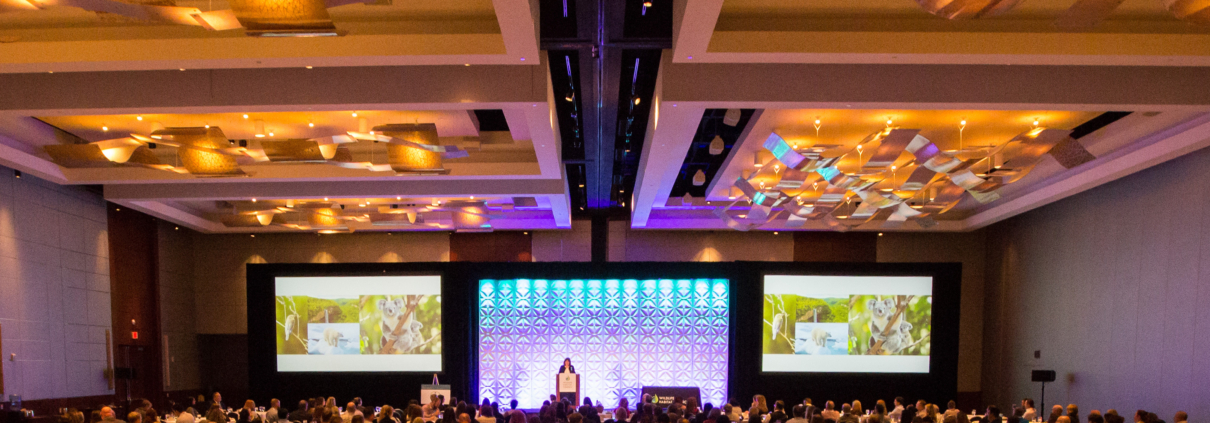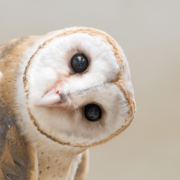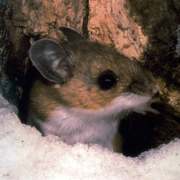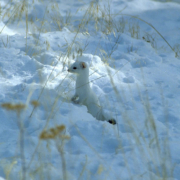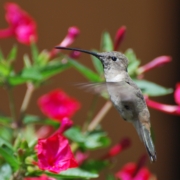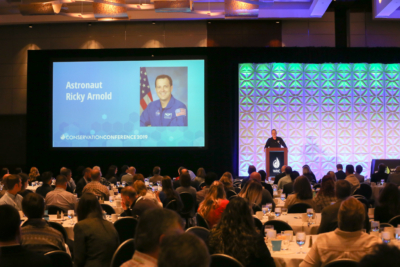State of Corporate Conservation 2019: Make Biodiversity Material
This blog post is a transcript of Margaret O’Gorman’s speech given at Conservation Conference 2019 in Baltimore, Maryland.
I would like to welcome you all here today for our annual Conservation Conference and because it’s the week before Thanksgiving, I’d like to offer thanks for everything you do to make this world a better place. Today and tomorrow we’re celebrating corporate conservation programs that are making the world a better place.
Because the world needs these programs very badly at the moment. This year has been a challenging year to live on our planet. It’s been unpredictable with economic reports pointing upwards, downwards and sideways, keeping us on the brink of a recession where the anticipation may be causing as much damage as the final crash will. It’s been unrelenting in the bad news from the reports by first the Intergovernmental Panel on Climate Change (IPCC) that showed we are on trend to warm the planet by 1.5o C as early as 2030 and then the Intergovernmental Panel and Biodiversity and Ecosystem Services (IPBES) that told us that “the average abundance of native species in most major land-based habitats has fallen by at least 20%, mostly since 1900.” The work of the IPBES got biodiversity on the front pages for the first time in decades. We’ve read stories about record numbers of birds in north America absent from our skies, we’ve seen forest fires impacting large parts of the Amazon Rain Forest – the very lungs of our planet – and we’ve heard about record melting in the Arctic and are now experiencing unprecedented bush fires in Australia where an early and aggressive fire season is threatening homes and prime koala habitat where an estimated 50% of koalas there may have been lost. We’ve seen school strikes, climate protests and unrest on every continent. To top it all off, we witness the daily adolescent squabbling of our elected leaders who seem intent to put Nero to shame and not just fiddle but fight while Rome burns.
Earlier this year, I was invited to speak at Ireland’s National Biodiversity Forum that gathered a who’s who of nature-professionals together for two days of conversation and planning. The president of Ireland, Michael D. Higgins opened the conference. In his speech he bemoaned the lack of progress on environmental issues since the Rio Earth Summit in 1992, saying “we don’t need any more reports to let us know the state we’re in. If we were coalminers, we’d be up to our knees in dead canaries by now.” View the full speech.
Sitting in the audience at the Forum, listening to the applause that followed this metaphor, I was also thinking how apt his metaphor was to business. President Higgins’ statement connected some dots in my head and led me from canaries in coal mines to the extensive risk assessments you all do on a regular basis. Canaries, as you all surely know, were used as an early detection system in coal mines, their deaths alerting miners to the presence of methane and carbon monoxide. If you think about it, canaries were tools of risk mitigation in the industrial revolution, a tool that lasted until the mid-1980s. President Higgins’ speech made me think about corporate risk assessment and the environment and how risks like – yes – methane and carbon monoxide but also financial markets and government regulations, cybersecurity and workforce development, and disruptive businesses and outdated technology remain front and center in corporate risk planning whereas risks from climate change and biodiversity – invisible like methane and carbon monoxide – remain under-assessed and undervalued.
And it’s not just me saying that. The CDP – formerly known as the Carbon Disclosure Project – has found a significant blind spot in corporate climate risk assessment. In a report earlier this year, it found that only 53% of the companies that reported into CDP identified inherent climate-related risk. It found that the private sector’s total reported risk from climate is severely undervalued. In fact, over 1,000 companies in the manufacturing sector alone identified not a single risk from climate and those that did focused more on narrow risks of government policy and regulations and shifting consumer patterns but very little risk was identified around infrastructure and supply chain, especially around resilience to the storms that are becoming more violent and less predictable, and to the fires and flooding that are becoming more common, almost predictable but no less damaging, with our changing climate. Looking west to California and PGE’s actions shows clearly that manifold risks exist in our changing, warming planet.
And that’s just climate risk. The risks associated with the biodiversity crisis are rarely addressed by the corporate world. And it’s not just the corporate world; the biodiversity crisis is the global issue nobody is talking about. The loss of nature has hardly been assessed at all.
It upsets me to my core that the biodiversity crisis remains so invisible. It is as threatening to our health and well-being as the climate crisis. But we’re just not talking about it. A study last year found that the climate crisis gets 8 times more coverage in the news media than the biodiversity crisis even though both issues generate the same number of reports and research studies.
This absence in attention shows. Every company we work with is deeply and impressively engaged in addressing their contribution to climate change, looking not just at the carbon footprint of the products they produce but also on the carbon footprint of the materials and processes they use to produce them and the carbon footprint of how their customers use them. They have parsed their carbon emissions into scopes 1, their direct emissions scope 2, the emissions made from the provider of their electricity and, their scope 3 emissions resulting from ingredients, distribution and the use of the product by the consumer. Having scope 3 emissions allows a company to assess the impact and identify opportunities for impact mitigation beyond its own operations.
But, do we do the same for biodiversity? No.
Ask a manufacturing company about their biodiversity impacts – it’s not material, they will say.
Ask a retail company about their biodiversity impacts – it’s not material, they will say.
Ask a tech company, a financial institution, a real estate developer, a road builder or an airline about their biodiversity impacts – it’s not material.
Yet, everything we eat, drink, wear, drive, work with, play with and dispose of has an impact on biodiversity. From the mines where we extract metals and sands – at least these industries accept a material impact – to the farms where we grow our food, through the factories, distribution routes, energy grids, stores and homes – through every act of consumption we are impacting biodiversity. So why do we limit our concern for biodiversity to direct impacts yet expand our carbon concern across the entire chain?
We need a scope 3 emissions approach for biodiversity. We need to consider nature across the entire system. We need to do that not just because nature is us, we need to do it because just like with climate change, the risks to society and business from the biodiversity crisis are significant but they are also in many ways unmeasurable and unpredictable. We can identify the risk to our food systems from the collapse of pollinator populations; the risk to our health from the collapse of air cleansing forests; the risks to our water quality from loss of marshes and bogs; and the risks to our wallets from having to pay for services that ecosystems give us for “free” today. But we can’t identify all the risks that may arise when a balanced system is pushed out of kilter.
We need to bring biodiversity to the fore, we need to talk about the issue and we need to value it more. We need to invest in solutions that work and the great thing about biodiversity, about recovering nature is that we know the solutions. We here are all engaged in that solution but we need to do more and invest more in nature.
We did an exercise recently. Kurt Eder, who works in our accounting department, calculated the total market capitalization of the membership of WHC. His analysis found that the market capitalization of all the companies that engage with WHC to implement conservation action on their lands is 3.3 trillion dollars. And do you know what these companies spend on biodiversity through their investments with WHC? 0.0001%. I know these companies are making investments in biodiversity elsewhere through regulated remediation and reclamation efforts, through philanthropic contributions of land or money, through in-kind contributions of employee hours for stream and beach clean-ups. But, do me a favor. Put your hand up if you think your company should allocate more resources for conservation and their WHC programs.
What am I talking about here when I talk about the biodiversity crisis? Some people call it the sixth extinction. Studies this year have shown declines in our insect populations, our bird populations, our mammal populations and our amphibian populations. There is not a single taxonomic group that is increasing in numbers. According to the International Union for the Conservation of Nature more than 28,000 species are threatened with extinction. According to the IPBES, 1 million species are threatened with extinction. According the World Wildlife Federation’s Living Planet Report we’ve seen a decline of 60% between 1970 and 2014.
I worry a lot about these numbers but also about a world without nature’s brilliant and boisterous diversity. A world muted by loss, discolored into grey and dominated by a few adaptable species including ourselves.
And this 6th great extinction is not just an extinction event. Extinction is when a species disappears from the earth completely, when no individuals remain to breed new individuals and no larger populations exist to support them. Extinction is forever. Once a species is gone, it is not coming back and the millions of years of genetic history contained within it are lost forever. Extinctions diminish species’ richness. But biodiversity loss also affects species abundance, the number of individuals of a specific species that exist. Species abundance, even of common species, is also under threat from the biodiversity crisis. The diversity of life on our planet brings so much to our lives – our shelter, food, fiber and fuel. The services it brings are worth US$125 trillion a year. But nature also provides us with cultural richness, the bird song we hear at dawn and dusk, the changing colors of leaves in a woodland, the sight of an elk moving across a wild and lonely place, a whale breaching, a cricket singing. Biodiversity is experienced by sight and by sound – the color and noise that is part of our planet. And as its loss continues and accelerates, colors and sounds will be extinguished one by one from our world – our lived experiences in nature will become monochrome and mute.
I want you to listen to this soundscape and imagine for a moment you are in the amazon rain forest…you can hear a cacophony of sound around you but suddenly, one by one the sounds begin to disappear, to be lost…forever…listen and imagine…and with the sound of a lonely stream as our only company in nature, we can sense how poor our lives become without nature, without biodiversity…poor and somewhat spooky …we may not know it in our risk disclosures but we do know it deep in our hearts and our souls that biodiversity loss is actually a very material issue.
But there is room for optimism. Global interest in the environment is high. A survey by the Pew Research Center found that 74% of Americans said the country should do what it takes to protect the environment. The latest Eurobarometer measure of concerns of European citizens saw anxiety for the environment rise to be the 4th issue of most concern out of 13 issues. Even the World Economic Forum understands. This year it listed biodiversity loss in its Global Risks Report as having an above average likelihood of occurring and causing an above average impact on the global economy.
So, there is growing interest and next year, 2020, has a lot riding on its young shoulders including an expectation that it be a super year for nature. The Convention on Biological Diversity (CBD) will be having a high-profile meeting to agree on its post-2020 agenda and will, for the first time, officially embrace the idea of mainstreaming biodiversity into the industries represented here, making room for industry to have a positive impact. Next year is the 50th year of Earth Day and to kick it off this year, we are pleased to welcome the venerable Smithsonian Institute Earth Optimism panel to our conference. Earth Optimism is designed to showcase what is possible, what can work and what is being done across the planet, and the Smithsonian will be hosting a summit on Earth Optimism in conjunction with Earth Day’s 50th birthday next year. We’ll also be getting in on the celebrations and will be launching, early next year, an Earth Day challenge to our members.
It’s great to see that trees are having a moment. Entire countries like Ethiopia commit to, and carry out, ambitious reforestation goals for climate and biodiversity benefits and our ability to measure the impacts of every tree we plant from the carbon it will sequester to the stormwater it will absorb helping drive action most recently with our efforts with the Port of Indiana .
Nature-based solutions are coming into their own and are acknowledged to have the potential to contribute 1/3 of the solution to the climate problem and provide untold co-benefits for biodiversity. To support this effort and thanks to generous funding from Arcelor Mittal, we launched Climate Action Works earlier this year to bridge a significant gap between the private sector’s action on carbon and the potential for their own lands to play a meaningful role in both climate mitigation and adaptation.
Let’s hope all these things will cause a contagion of interest because concern for biodiversity can be infectious although our politicians do seem to be immune!
At WHC we have some metrics that clearly show an interest in what we are doing and value in our efforts to connect you to nature in a meaningful way. We see increasing interest in our programs and publications. Who has attended a WHC webinar this year? Since the first educational webinar launched in 2012, we’ve provided nature-based learning to over 12,000 people and last year we offered 23 webinars with 600 people viewing the excellent webinar on native bees.
If you attended a webinar and as you are attending Conference, you are a beneficiary of the hard work and the inspired contributions of Thelma Redick, our Sr. Director for Conservation Content and Partnerships. This is Thelma’s last conference with us. She is taking a career break to tend her garden and get active in her community. Thelma has poured her heart and soul as well as a fair amount of blood, sweat and tears into WHC over 17 years and is leaving a wonderful legacy of engagement, education and partnerships. Please join me in a round of applause to thank and honor Thelma.
Now back to business. Who downloaded a white paper from WHC this year? Since we published our first white paper in 2017, over 3,000 people have downloaded one of our 10 papers and we published two this year – one on the many ways corporate habitat can be used to protect, restore and manage bird populations sponsored by Ontario Power Generation and another one that links corporate conservation action to the UN Sustainable Development Goals sponsored by Chemours. Keep your eyes peeled for a third paper currently in production that will shine the light on how corporate conservation is an ideal vehicle for meaningful and sustainable employee engagement and is appropriately sponsored by Waste Management. We thank our sponsors for allowing us to create and share this content about your great work.
Your great work is helping make biodiversity material. WHC members from companies both large and small engage in nature, through conservation action, species management and ecological restoration efforts in many different and interesting ways. These ways need to be scaled. They need to be replicated. They need to be better funded. The strategies and initiatives need to be mainstreamed into your planning and doing but they also need to be celebrated. For example, this year we entered into some great engagements with member companies – with Toyota North America on an exciting project to help their facilities identify indicator species for their 2050 “living in harmony with nature” goals, and with Chemours, Kinder Morgan, Waste Management and CEMEX to develop tools to educate and engage facilities on meaningful stewardship efforts. We are shepherding Lafarge Canada and Peugeot through corporate disruptions to leverage existing efforts to create a conservation cultures. We are helping Fiat Chrysler America (FCA) to not only meet but exceed their Community Benefits obligations associated with their plant expansion on the east side of Detroit. Greg Rose from FCA is determined to bring nature back to this part of the city. This effort dovetails nicely with our DTE Energy-funded program to engage more companies in more community efforts in the region. We continue to engage with the Suppliers Partnership for the Environment, supporting the most popular initiative in the partnership – pollinator gardens at suppliers’ facilities.
We don’t just celebrate your work here at Conference. We celebrate your work to audiences across the world telling your story in Mexico, Ireland and elsewhere. We spoke to a lot of people this year – we spoke to lawyers and engineers, school children and academics, conservationists and chemists. We’ve talked to the energy sector, to EHS professionals, to arborists and pollinator protectors. We’ve told your stories and exhorted others to follow your lead.
And we were published this year.
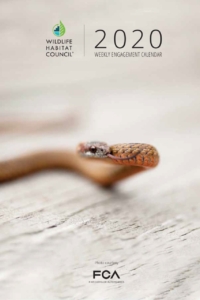 Published in scientific journal Environment, Development and Sustainability a paper by ExxonMobil’s Alex Ireland and Laura Napoli coauthored with WHC staffer Emily Volstad, found that corporate conservation efforts have the potential to provide conservation benefits that are comparable to some financially incentivized programs.
Published in scientific journal Environment, Development and Sustainability a paper by ExxonMobil’s Alex Ireland and Laura Napoli coauthored with WHC staffer Emily Volstad, found that corporate conservation efforts have the potential to provide conservation benefits that are comparable to some financially incentivized programs.- In the proceedings of the ROW 12th International Symposium WHC staff Josiane Bonneau and Sydney Muchapublished a paper to guide Rights of Way managers to incorporate climate change adaptation strategies into their veg management practices.
- Rob Campbell published a great piece about Vulcan Material’s Macon Quarry in NSSGA’s Stone, Sand and Gravel Review.
- And of course, we published our wonderful calendar – the cover is one of my favorites ever and a big thank you to all who contributed the color and beauty of nature to this publication including FCA for sponsoring this great cover picture.
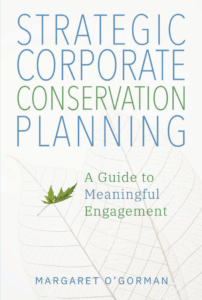 And I wrote and published a book…why you might ask? Indeed I asked myself that same question quite a few times but I wrote this book for a number of reasons. I wrote this book out of frustration, out of pride, out of necessity but mostly out of hope. I wrote this book out of frustration that too many companies don’t know the potential of their lands to make a positive difference for biodiversity and climate and too many NGOs see companies as potential funders, not partners. I wrote the book out of pride for WHC and the thousands of corporate employees, who for three decades have been achieving significant outcomes for biodiversity through a unique model of strategic engagement and recognition that was developed through trial and error, over economic booms and busts and where experience is informed by action and not theory. I wrote this book out of necessity. Only 15% of lands worldwide are protected for nature so all lands are needed to address this issue especially privately owned corporate lands that are not being used for operations but also not being managed for biodiversity.
And I wrote and published a book…why you might ask? Indeed I asked myself that same question quite a few times but I wrote this book for a number of reasons. I wrote this book out of frustration, out of pride, out of necessity but mostly out of hope. I wrote this book out of frustration that too many companies don’t know the potential of their lands to make a positive difference for biodiversity and climate and too many NGOs see companies as potential funders, not partners. I wrote the book out of pride for WHC and the thousands of corporate employees, who for three decades have been achieving significant outcomes for biodiversity through a unique model of strategic engagement and recognition that was developed through trial and error, over economic booms and busts and where experience is informed by action and not theory. I wrote this book out of necessity. Only 15% of lands worldwide are protected for nature so all lands are needed to address this issue especially privately owned corporate lands that are not being used for operations but also not being managed for biodiversity.
I wrote this book out of hope – we have to continue to work, to plant, to restore and to manage our lands for nature and we – you – have the lands to do it with. Nature is amazing. It is resilient. It is responsive. It is smarter than we are and when we give it a kick start and get out of the way, the results can be absolutely magical. This is the hope that I poured into this book – marry the pragmatism of corporate needs with the magic of nature and create an outcome that benefits us all. We are thrilled, with the generous support of CEMEX… to be able to present copies of the book to everyone in attendance today and I am happy to sign anyone’s book – in the exhibit hall after this speech.
But I couldn’t have written this book without you, the plans you make, the strategies you develop and the programs you do. The book is a celebration of everyone in this room who takes an idea, convenes a team, moves some earth, plant some seeds and makes this world a better place and if anyone in this room ever thinks about writing a book, please consider working with Island Press, they’re just a great bunch of people working hard to get books on nature and community out into the world.
But not before you enjoy and engage with Conference over the next two days. This Conference is for you. It is designed to celebrate success, share strategies and recognize exceptional efforts. This year we will be presenting project awards for outstanding efforts across 18 themes. We will also be presenting an award to the best Gold Program, the best effort at employee engagement and a corporate award for conservation leadership. These awards are always competitive, and this year was no different. It’s not easy to be nominated so let’s celebrate that. Let’s have a round of applause for all the projects and programs nominated for awards this year.
We have great content this year at Conference with a NASA astronaut Ricky Arnold who will be joining 47 other speakers for 12 hours of learning over the next two days. In addition we have 6 hours of networking and 5 hours of recognition time. We have 43 exhibitors in the hall outside ranging from WHC member companies to our educational partners Project Wet, Project Wild and Project Learning Tree. All this information is in the Conference app so make sure you download it. Thank you to all the speakers, exhibitors and sponsors that made our Conference possible this year. Can we have a little round of applause for the many groups and individuals that made today and tomorrow possible?
This year, as many of you know, we did a much-needed update to our certification application platform to respond to our needs for a robust reviewer management system but most importantly your needs for data for your reporting and a cleaner interface. Just like with most technology buys, this did not go as smoothly as we wanted and we found ourselves launching later than we wanted to which impacted your ability to submit applications according to your timelines. I am so sorry that that happened to you this year and hope that we will never have to buy new technology ever again. But thanks to this investment, we will be building out the reporting aspect of the platform throughout next year and anticipate having some great reports that can help you whether you need to data for ISO verification, GRI reporting or internal communications to leadership. This entire build has been a challenge – try buying the right technology at a price an NGO can afford but Emily and Caitlin and the rest of the team are poised to wring every last drop of functionality from this system to support your needs.
Despite all the software shenanigans and thanks to you, Emily and her team received 235 program applications made up of 889 project applications. We welcomed Aristeo as a company with a first-time certification for their pollinator garden – Aristeo is a full service construction company based in Michigan. We welcome them to the fold.
This year a team of 41 individual reviewers looked at your applications – these are the people who evaluate if your conservation objectives are sound, your monitoring is acceptable and the answers to the questions are understandable. They assign the score to your project and the tier or recognition. This year 64 Silver and 44 Gold Programs were recognized as exceeding minimum requirements and being exceptional. Thanks to you, we now have 700 certified programs in 28 countries, 49 US states/territories and we welcomed a new country, Latvia, into the fold this year with a certification at CEMEX’s – Caunes Quarry.
Applications for avian projects continue to be the most common projects received. 385 avian projects were submitted this year. The most common habitat projects are on grassland habitat and the most common education are in Awareness and Community Engagement – underlining one of the unique and important aspects of Conservation Certification, the human dimension that connects employees and communities around acts of conservation that matter.
And as you know all acts of conservation matter because our natural world matters. Just think about it. Think about a butterfly. It seems too slight, so flimsy. It weighs 1/10 that of a dime. I recently read about a monarch that was tagged in Canada and re-sighted in Mexico 60 days later. It had flown nearly 2500 miles over that time. Think about a frog. They seem so fragile yet they are found in some of the harshest ecoregions on our planet from the Arctic Circle to the rain forests and everywhere in between. The frogs that live in cold and temperate climates hibernate in water, surviving on breathing oxygen from the mud they bury into and allowing nonessential organs to freeze while maintaining blood flow by having antifreeze in their veins.
Think about trees. They seem so solitary yet they are in constant contact with other trees, communicating and sharing resources through a vast underground network of mycorrhizal fungi where a mother tree is connected to all other trees in a forest and manages water and nutrients. Think about nature and its amazingness, its resilience and its capacity to adapt and to recover. And adapt and recover it must.
While extinction itself is a one-way street, loss of species abundance is not. When I first started working on rare and imperiled species, I did it in New Jersey where in the late 1980s, there remained one pair of bald eagles in the state, historically low populations of osprey and other species like the Pine Barrens tree frog and eastern tiger salamander were all at serious risk of extinction. Today New Jersey has 238 pairs of bald eagles and historically high numbers of ospreys. The Pine Barrens tree frog and eastern tiger salamander are slowing gaining ground. Recovery is possible. Restoration of biodiversity is possible. We can turn the corner for many species by combining regulations like the ESA, species management by wildlife biologists and volunteers and lands management – helping habitat do its thing and provide for species breeding, migrating and hibernating needs. We can make a positive difference and I have a second soundscape that proves it. This soundscape contains the species that we have recovered – the bald eagle, peregrine falcon, osprey and whooping crane, all species brought back from the brink and in the background, the countless crickets and frogs that we keep our eye in to ensure that their abundance never declines to critical levels. Listen to this soundscape and imagine it as being secure for you when you’re sitting on your porch in old age and retirement but also when you grand kids and their grand kids are sitting on their porches in old age and retirement. It’s a legacy we can leave if we consider nature, mainstream biodiversity and look at all of our lands as having potential for nature-based efforts.
[player id=40548]
But you’re not sitting on your porch in retirement. You’re still active and we all have work to do. My call to action to you is a simple one – let’s make biodiversity material across all aspects of your company. Consider nature – consider where you sit in your company or your community. Where are the intersections? What division are you in, what department, what ties do you have to different parts of the company or even to different companies, what budget do you control? I want you all to reach across your own professional fence lines and engage someone else in biodiversity action whether a colleague, a vendor, a peer or a competitor. If you operate in facilities management, reach out to a colleague in remediation. If you’re engaged through sustainability, connect with someone in HR. Infect the finance people with a love of nature. If you’re a member of a trade association representing your industry, introduce biodiversity at the next meeting. Let’s make nature material, let’s make biodiversity matter.
In the book, I end with a vision of how the world could look if business fully integrated nature, if business mainstreamed biodiversity and designed its very existence to live in true harmony with nature. I say I like to imagine a future journey along the urban/rural transect from densely populated cities through suburban towns to sparsely populated countryside and wilderness. Along this journey, industry’s impact is no longer seen as one of dominance over nature but instead as a comprehensively designed integration with nature. In this future, the anonymous offices in central business districts sport green walls and green roofs that provide habitat for pollinators, birds, and other species dwelling in the city or just passing through. Buildings are darkened at night as a matter of course to protect migratory species. Urban industrial areas are managing their buffer lands for biodiversity. Suburban office parks are meadows, corporate campuses are forests, and smaller corporate locations such as gas stations, shopping malls, and shipping depots manage for nature not purely for aesthetics but also for ecological functionality. When the journey ends in rural or wilderness areas, the impact of industry on the landscape has a bigger footprint in mines and quarries. But in this greener future, the old scars on the land are no longer visible, thanks to ecological remediation and dynamic reclamation, while current operations integrate nature in new and innovative ways. This future can be realized if corporate landowners and conservation partners take the time to plan and build programs that will bring long-term benefit to business, biodiversity, and community.
Here in this room are the planners and the builders and the people who can mainstream nature into corporate land holdings across the planet. When we do that, when we succeed to create that new landscape, we can sit our porches, listen to the sounds of nature and be proud of the role we played.
Thank you.
